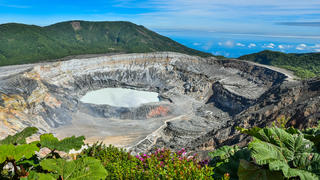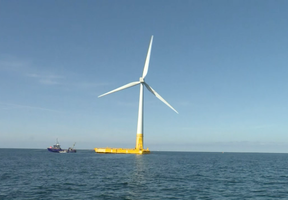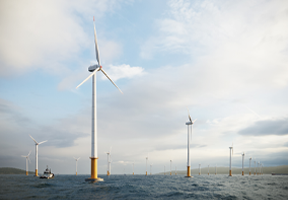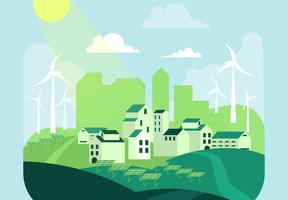Costa Rica, the Renewable Electricity Country
10 min read
Costa Rica is one of the most proactive countries in the world in the fight against 1. It produces nearly 100% of its from renewable sources, although it remains very dependent on oil for powering transportation and for heating its homes.

© SHUTTERSTOCK - Costa Rica is focusing on renewable energies such as hydro, wind and geothermal. This photo shows the 2,700 meter-high Poás Volcano.
Classified by the International Monetary Fund (IMF) as an “emerging market”, the per capita gross domestic product (GDP) of this small Central American country is equal to that of Brazil and its poverty level (22%) is below the Latin-American average. Its economy is driven by tourism, exports of flowers and fruits and a Free Trade Zone Regime under which high‑tech multinationals have set up operations.
A Key Player in the Energy Transition
Since 1949, the Costa Rican government has been very proactive. It has made the innovative decision to abolish its military and to reallocate military spending to increasing the electrification of the country, particularly by building hydropower facilities and expanding infrastructure in rural areas. The electricity sector has been nationalized and private companies still only account for one-third of energy activities. However, the country is very open to foreign direct investment.
A narrow strip of land between the Atlantic and Pacific Oceans, Costa Rica is vulnerable to extreme weather events and has been combating climate change for many years. However, given its characteristics, it does not provide a replicable model for the world’s biggest countries.
Costa Rica has a population of less than 5 million and is ten times smaller than metropolitan France. It does not have any major industries, which reduces its energy needs. In addition, it boasts exceptional natural resources such as extensive forests with a high carbon absorption capacity, volcanic activity that generates energy and an abundance of water with a high hydropower potential (outside of occasional drought periods).
As its first measure, the Costa Rican government curbed deforestation, which was being carried out rapidly to support livestock farming. The country’s forest cover fell from 63% in 1960 to 21% in 1987, but it has now climbed back up to 50% thanks to active forestry management. Costa Rica was one of the pioneers of the carbon offset program introduced by the United Nations (U.N.), under which greenhouse gas emitters can buy credits guaranteeing a reduction in emissions elsewhere. Since 1996, Costa Rica has sold 200,000 metric tons in emissions reductions generated by reforestation operations to Norwegian energy producers.
An Almost 100% Renewable Power Generation Mix
Costa Rica then launched a coordinated plan, leveraging its three main resources: water, geothermal energy and wind. Today, almost 100% of its electricity is generated from renewable sources (98% in 2016). The contribution of each energy source varies depending on weather conditions (e.g., wind and rain), with hydro accounting for the biggest percentage of the mix2. In the first quarter of 2017, hydro represented 69.3% of power production while wind represented 16.2% and geothermal 11.2%. Trailing far behind were biomass (2.2%) and solar (0.16%), but these sources are being expanded.
Hydro – In 2016, Costa Rica inaugurated the Reventazón hydropower facility (300 megawatts), which is the most powerful in Central America. The El Diquis facility, which will have a power capacity of 650 megawatts, is set to come on line in 2025. However, the authorities still have to convince the indigenous population in the region.
Geothermal – Facilitated by a very dense network of volcanoes, economically recoverable geothermal energy has a potential future power capacity of 1,000 megawatts. There are already half a dozen geothermal plants in Costa Rica, such as on the slopes of the Miravalles volcano. Here, heat is captured by 25 wells that are more than 1,600 meters underground, providing the plant with a power capacity of more than 160 megawatts. The national electricity provider (ICE) is looking to build another plant on the Rincón de la Vieja volcano.
Wind – Wind farms are located in the mountainous part of the country, where peaks rise to more than 2,000 meters. Solar power is expanding, but it still only accounts for a very small percentage of electricity production.
Role of Oil
Electricity consumption has tripled in the last 15 years, but per capita consumption in 2014 was 9% below the Latin American average3. Electricity represents less than 25% of total energy consumption, with oil products – essentially for transportation – representing 60% and biomass for heating homes representing 17.1%.
The transportation industry accounts for two-thirds of oil and gas consumption and 54% of CO2 emissions. The vehicle fleet is aging and many of the 1.4 million cars on the road therefore have poor emissions performance. There are no electric vehicles and public transportation is underdeveloped. The Costa Rican government is spearheading a project to build a light rail system in the greater San José area, but securing funding has been a challenge.
Costa Rica had set itself the objective of becoming “carbon neutral” by 2021, that is to say to have a net zero , but it has now pushed this back to 2085. Nevertheless, its proactive approach to combating climate change and protecting (one-quarter of its territory has protected area status) is already being used to cultivate an image of a “tourist paradise”. Tourism – and particularly eco-tourism – is the country’s primary source of revenue.





















